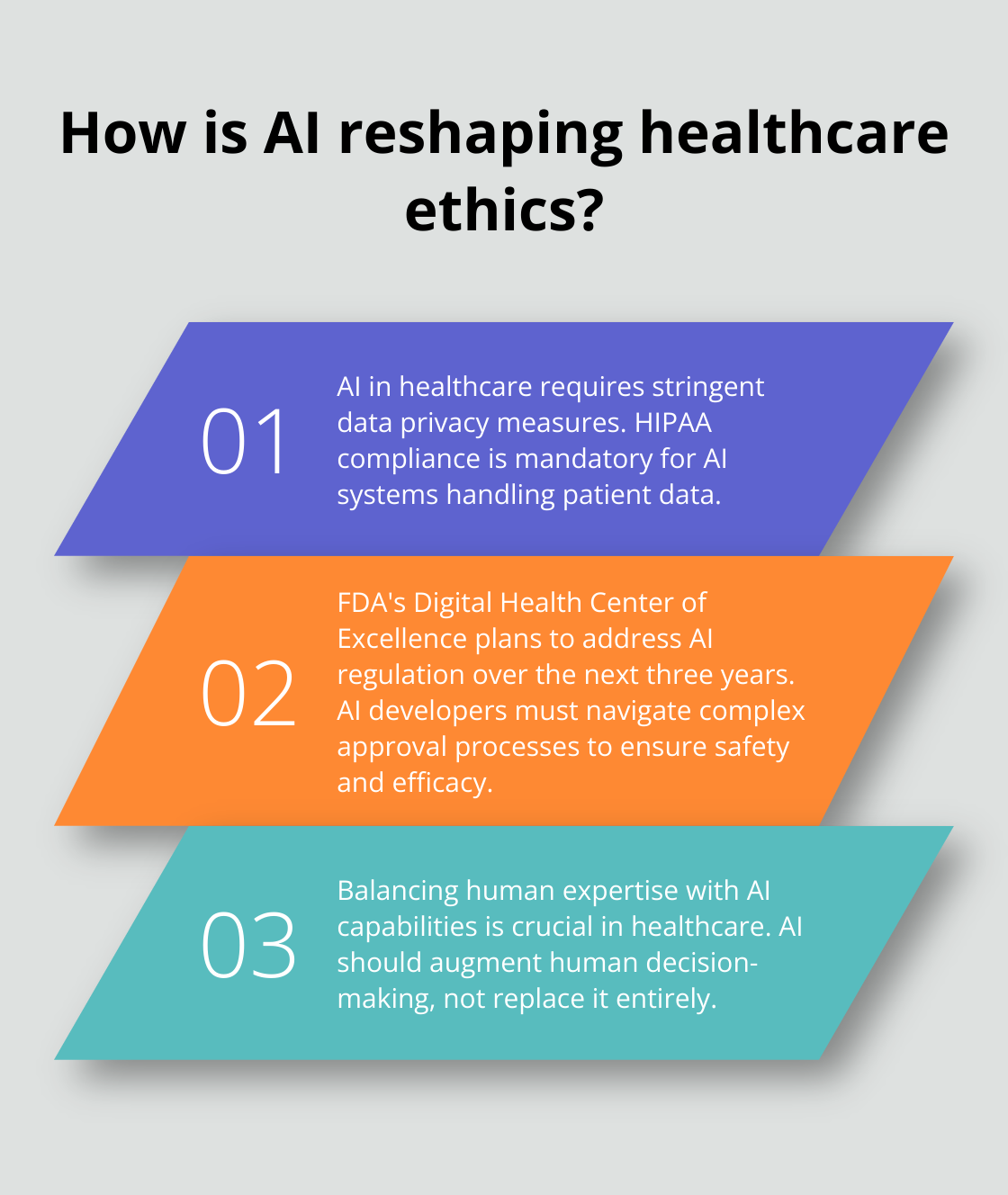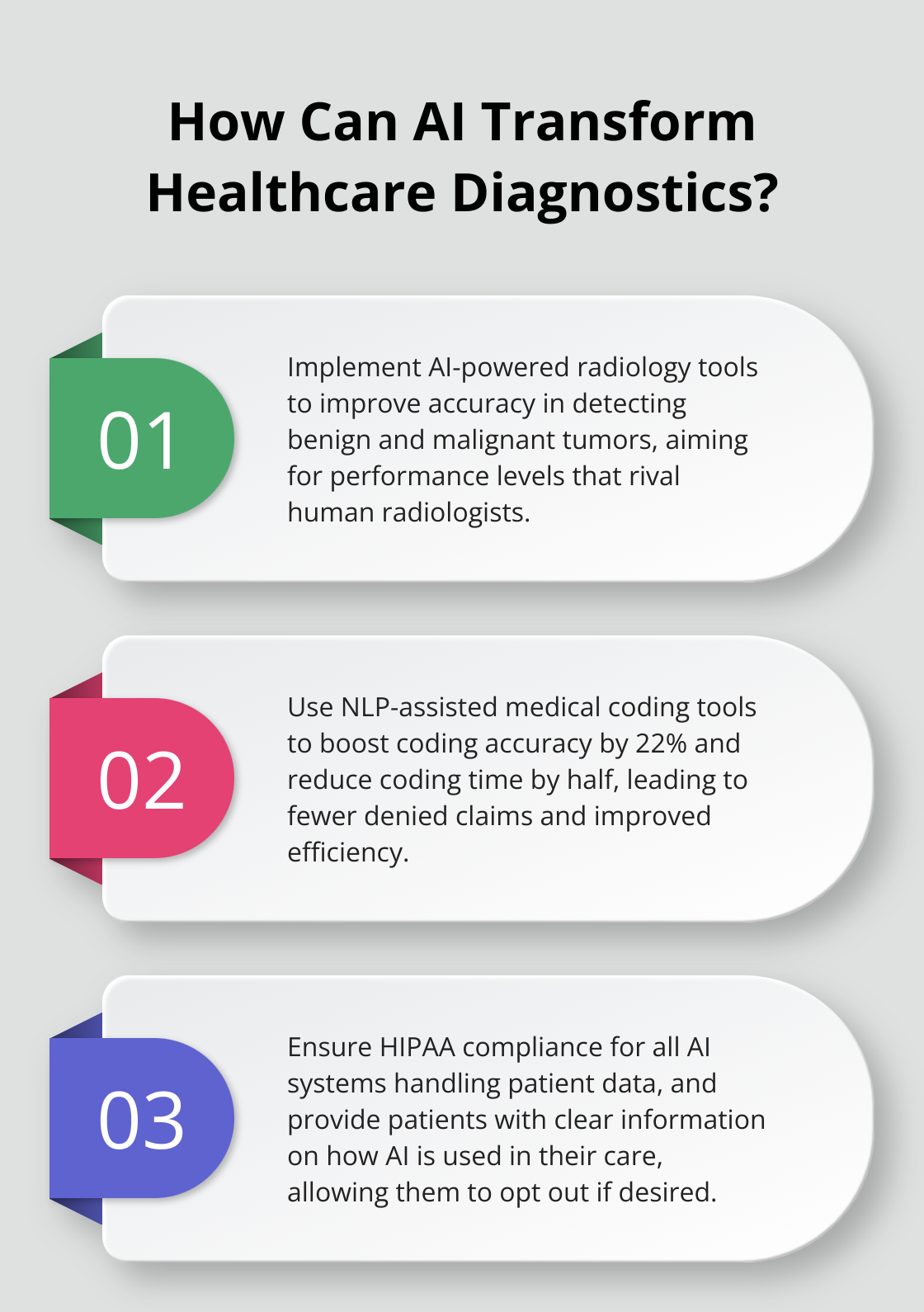AI diagnostics… let’s talk about how this digital Einstein is flipping healthcare on its head, folks. We’re moving from stethoscopes to silicon chips—sci-fi level stuff. It’s the next chapter in how we pin down and tackle diseases. From reading medical images like they’re Dr. Dolittle and automating paperwork because, let’s face it, nobody got into medicine for the admin—AI is bringing its A-game in precision and productivity all over the medical arena.
Over at ScriberJoy (yes, we’re tooting our own horn here), we’re front-row to AI reshaping clinics, making patient outcomes look like they’re on steroids, and giving admin tasks a swift kick in the rear. Let’s dive into this brave new world of AI-driven diagnostics and paperwork wizardry, while also tackling the hurdles and ethical tightropes that come with this digital revolution. Exciting? Absolutely. Complex? You bet. But hey, so’s your favorite Netflix series.
How AI Transforms Medical Imaging
AI is shaking up medical imaging and diagnostics – pushing the envelope on what’s doable in healthcare. This tech is changing the game in patient care and clinical workflows, serving up accuracy and efficiency like never before.
Supercharging Radiology Accuracy
AI models – they’re not just for fun anymore. These marvels can tell the difference between benign and malignant tumors in mammograms, hitting performance levels that rival human radiologists. This bump in accuracy means earlier interventions, better outcomes… sooner.
Spotting Diseases Before They Strike
The thing with early detection is it’s a life-saver. AI diagnostic tools quicken the pace in understanding complex images and nail early detection, ultimately enhancing patient care. Machine learning models – they’re like those eagle-eyed experts – see those fine details in medical images the human eye might just cruise past.
Tailoring Treatments to Individual Patients
Say goodbye to the one-size-fits-all medicine approach. AI is ushering in personalized treatment plans by churning through oceans of patient data. Take the Mayo Clinic, for instance. Their AI algorithms help oncologists whip up tailor-made treatment plans by factoring in all the nitty-gritty: genetic make-up, treatment history, and more.
Augmenting Human Expertise
These advances are a big deal. But let’s remember, AI is here to back up – not boot out – our human experts. The sweet spot is mixing AI’s analytical muscle with the seasoned intuition of healthcare pros. This blend of human savvy and machine playbook sets the stage for spot-on diagnoses and custom-fit treatment plans.

AI isn’t just a game-changer in medical imaging; it’s flipping the script in all corners of healthcare. Check out medical documentation. AI-driven tools (you’ve heard of ScribeJoy?) are tidying up that process, making it faster, sharper, and… well, better. So, let’s dig into how natural language processing is turning the tide for healthcare providers tackling medical records and documentation.
How AI Transforms Medical Documentation
Ah, Natural Language Processing (NLP) – it’s here to shake up medical documentation. Faster, smarter, and less of a headache for healthcare workers. This tech is flipping the script on how docs jot down notes, back up clinical calls, and deal with billing chaos.
Streamlining Medical Transcription
Gone are the marathon sessions of doctors pounding away at keyboards. Now, NLP tools step in, capturing medical chats in real time, turning those spoken words into neat, searchable text. A study dove into how virtual scribes affect the time doctors spend on digital paper trails.

Those AI transcription tools (think ScribeJoy) – they team up with human eyes to nail down greater than 99% accuracy in medical docs. This two-fold method nails the medical lingo while bringing that lightning speed courtesy of AI.
Enhancing Clinical Decision Support
But wait… there’s more! NLP doesn’t just eavesdrop; it gets analytical. AI reels in all that medical literature and patient data to dish out real-time insights – arm-in-arm with clinical decision-making. Like, NLP in healthcare aiding decision-makers with bite-sized health info on demand.
System’s got your back – flags drug clashes, highlights patient’s past, suggests diagnoses based on symptoms you’ve got on file. This ups patient care and keeps docs in the know – cutting-edge kind of knowledge.
Revolutionizing Medical Coding and Billing
Ever heard someone say “I love medical coding”? Didn’t think so. But NLP’s flipping the game. AI jumps in, slaps on the right medical codes from clinical notes, slashing errors and cranking up coding speed.
One study out of the Journal of the American Medical Informatics Association found NLP-assisted coding boosted accuracy by 22% – cut coding time in half. Less time, less money down the drain – more accuracy, fewer denied claims. It’s like the trifecta of healthcare wins.
Improving Patient Care Through Better Documentation
Those ripple effects? More waves than a stormy sea. Better docs mean better care. Spot-on, well-rounded records mean docs make sharper calls, track patient progress with ease, and roll out custom care.
(Example alert: AI-doc-tools tag crucial info from old visits – stops the essential stuff from vanishing into the void.)
As AI keeps strolling into the medical doc arena, get set for even bigger leaps in efficiency, cracking accuracy, and patient wins. But with big leaps come big questions – ethical ones. Up next? We tackle those challenges head-on and chat about the healthcare industry’s roadmap for venturing through them wisely.
Navigating AI’s Ethical Maze in Healthcare
AI in healthcare is-well, it’s kind of a tangled web of ethical quagmires and tech hurdles. This chapter dives into the big stuff healthcare folks and AI geeks need to tackle.
The Data Privacy Tightrope
Healthcare data? Super sensitive stuff. Yet, these AI systems gobble up data like it’s all-you-can-eat buffet time…but safeguarding this info is crucial.

HIPAA compliance is non-negotiable for any AI dabbling in patient data. Healthcare folks gotta put up serious defenses to guard that sensitive info flying around in digital form. Patients need the deets on how AI is juggling their info and should have the power to say “nah” to AI stepping in on their care if they choose.
Regulatory Hurdles and FDA Approval
The FDA? Oh man, it’s got its hands full trying to get a grip on AI in healthcare. Old-school approval methods? Lagging way behind those turbo-charged self-learning algorithms. Enter the FDA’s Digital Health Center of Excellence, swooping in with big plans for the next three years.
AI creators gotta thread their way through a maze of approvals, proving they’ve got safety and results nailed down. The FDA’s trying out some new tricks, like keeping tabs on AI performance out in the real world, to keep innovation rolling while prioritizing patient well-being.
Human vs. Machine: Finding the Balance
AI’s not here to dethrone the human touch in healthcare. It’s more about adding some beef to human smarts-but finding that sweet spot between human wisdom and AI intel? Tough nut to crack.
Lean too hard on AI and medical pros might just lose their mojo. On the flip side, shrugging off AI’s tips could mean blowing chances for better patient care.
The answer? Teamwork in decision-making. AI should be the sidekick, boosting what docs can do. Docs need to be schooled on when AI’s on point and when to let their instincts lead.
Transparency and Patient Trust
Healthcare providers need to break down AI-driven decisions for patients-crystal clear. Transparency is the magic word that builds trust and arms patients with the smarts to steer their own healthcare ship.
When AI pipes up with a treatment suggestion, docs should break it down, plain and simple. This strategy dials up patient faith in AI-backed healthcare.
Ethical AI Development
AI creators in the healthcare sector face a heap of unique ethical dilemmas. The mission? Keep it fair, smash bias, and make sure algorithms aren’t feeding into health inequities.
Regular check-ins on AI systems can catch and fix biases. Building teams with a diverse lineup-including healthcare pros, ethics buffs, and patient champs-can shape AI that’s fairer and more moral.
Final Thoughts
AI diagnostics and documentation-where are we heading with this? Well, it’s reshaping healthcare as we know it. We’re talking a new era, folks-one that’s all about precision, efficiency, and keeping the focus squarely on the patient. These tech marvels are a game-changer for healthcare professionals, flipping the script on the entire ecosystem. The crystal ball shows AI’s future here is big-like, really big. We’re looking at algorithms getting sharper, crunching complex medical data like it’s child’s play, all in the name of better treatments.

Now, if you’re in healthcare and not hopping on the AI train-you’re missing the boat. It’s not just about keeping up; it’s about stepping up practice efficiency. Take a gander at ScribeJoy-AI-powered medical transcription that’s blazing fast with a reassuring human touch. By adopting tools like these, healthcare pros can toss away some of that pesky admin load and get back to what they care about-patient care.
AI in healthcare? Fasten your seatbelts-it’s only gonna accelerate. Early adopters? They’re setting themselves up to deliver top-notch care. But let’s not sidestep the big stuff: ethics, data privacy, and regulatory red tape. These are going to be front and center in every convo. The future of healthcare? It’s already knocking on our door, powered by AI, and it’s flipping the entire approach to diagnosis and treatment on its head.

Leave a Reply
You must be logged in to post a comment.